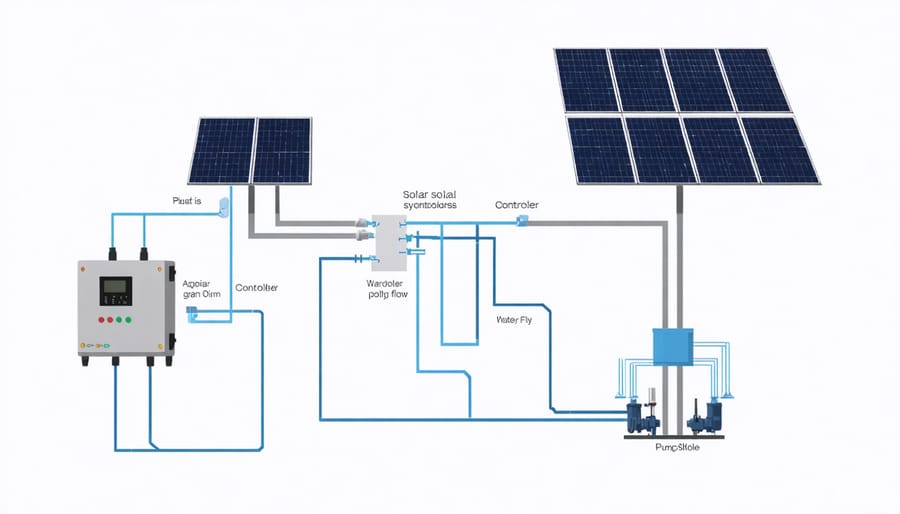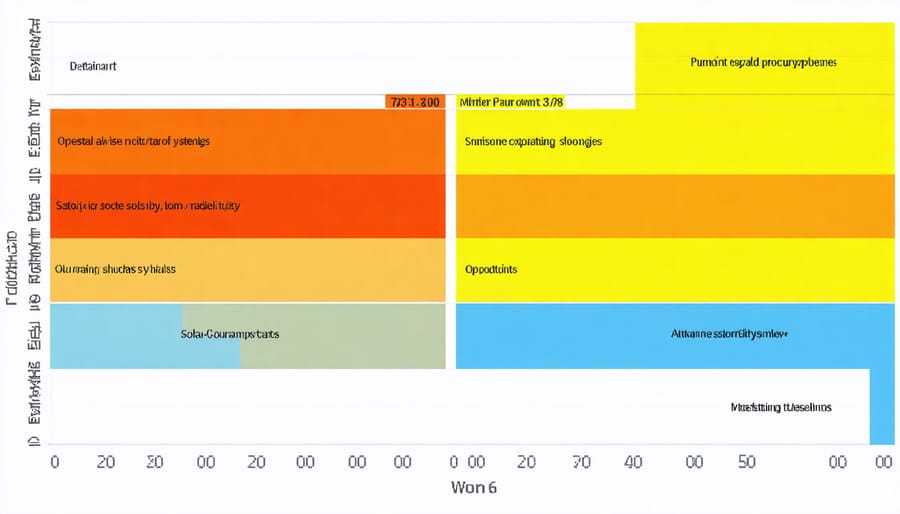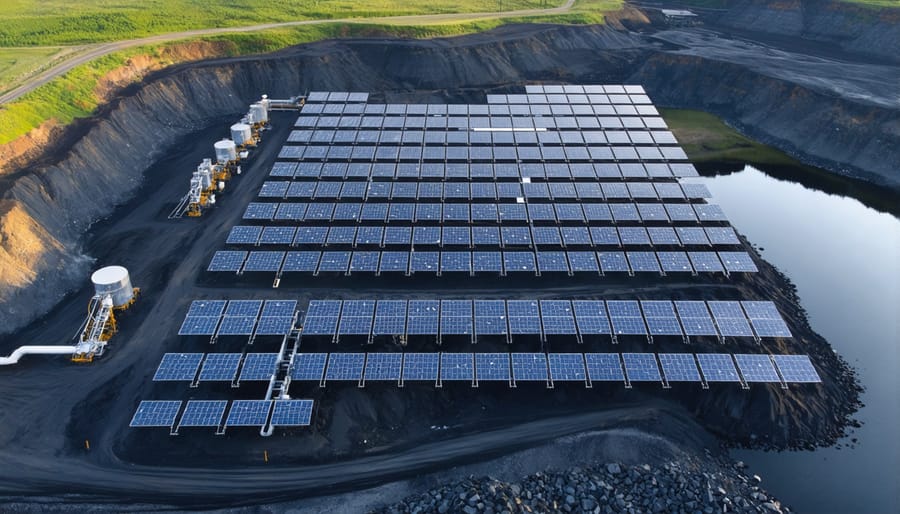Solar Water Pumps Transform Mining Operations: Sustainable Irrigation Solutions That Pay For Themselves

Solar-powered irrigation pumps are revolutionizing agricultural sustainability across Europe, transforming the mining industry and farming practices through innovative water management solutions. These advanced systems harness solar energy to power efficient pumping mechanisms, delivering reliable irrigation while reducing operational costs by up to 70% compared to traditional diesel pumps.
Modern solar irrigation pumps integrate seamlessly with smart monitoring systems, enabling precise water distribution across vast agricultural landscapes. The technology combines high-efficiency photovoltaic panels, specialized DC/AC pumps, and sophisticated controllers that automatically adjust water flow based on real-time soil moisture data and weather conditions.
For European farmers and agricultural businesses, these systems represent a critical advancement in sustainable farming practices. With EU regulations increasingly focusing on renewable energy adoption and water conservation, solar irrigation pumps offer a dual benefit: meeting compliance requirements while significantly reducing carbon footprint. The systems’ ability to operate independently of the grid makes them particularly valuable in remote agricultural areas, ensuring consistent irrigation even in locations where traditional power infrastructure is limited or unreliable.
How Solar Water Pumps Revolutionize Mining Irrigation
Core Components and Operation
A solar water pump system consists of several essential components working in harmony to deliver efficient irrigation solutions. At its heart lies the photovoltaic (PV) array, which converts sunlight into electrical energy. These solar panels connect to a controller unit that optimises power output and protects the system from voltage fluctuations.
The pump itself, typically either submersible or surface-mounted, converts this electrical energy into mechanical power. Submersible pumps are ideal for deep wells and boreholes, while surface pumps excel in scenarios with water sources close to ground level, such as lakes or storage tanks.
A vital component is the inverter, which transforms the DC power from solar panels into AC power when required by specific pump types. Many modern systems also incorporate smart controllers with features like automatic shut-off, flow monitoring, and remote operation capabilities.
The system may include water storage solutions, allowing for irrigation during non-sunlight hours. Additional components such as filters, pressure switches, and monitoring systems ensure optimal performance and longevity while maintaining water quality standards for agricultural applications.

Integration with Existing Mining Infrastructure
Integrating solar water pumps into existing mining infrastructure requires careful planning and systematic implementation. Modern solar-powered mining operations are designed with compatibility in mind, featuring standardized connection points and adaptable control systems that seamlessly work with legacy equipment.
The integration process typically begins with a comprehensive site assessment, evaluating current power distribution networks, water management systems, and operational requirements. Key considerations include existing pipeline configurations, pressure requirements, and flow rates necessary for specific mining processes.
Most contemporary solar pump systems come equipped with smart controllers that can communicate with standard mining SCADA systems, enabling unified monitoring and control. These controllers facilitate automatic switching between solar and grid power, ensuring continuous operation during varying weather conditions.
To minimize disruption during installation, mining operators often implement a phased integration approach. This involves installing solar pumps parallel to existing systems, allowing for gradual transition and thorough testing before full implementation. The process typically requires minimal modifications to existing infrastructure, as modern solar pump systems are designed with industry-standard fittings and connections.
For optimal integration, it’s crucial to consider factors such as:
– Compatible voltage and current specifications
– Backup power systems integration
– Monitoring and control system compatibility
– Maintenance access requirements
– Safety system coordination
Environmental and Economic Benefits
Reducing Carbon Footprint
Solar-powered irrigation pumps play a crucial role in reducing operational costs and emissions across European agricultural and industrial sectors. By replacing traditional diesel or grid-powered pumps, these systems significantly decrease carbon dioxide emissions, with typical installations saving between 3-5 tonnes of CO2 annually per pump unit.
The environmental benefits extend beyond carbon reduction. Solar irrigation pumps eliminate the risk of fuel spills and groundwater contamination associated with diesel systems. They operate silently, reducing noise pollution that can affect local wildlife and communities. Furthermore, these systems require minimal maintenance, reducing the environmental impact of frequent service visits and replacement parts.
Smart controllers in modern solar pumps optimize water usage by adjusting flow rates based on real-time conditions, preventing over-extraction of groundwater resources. This precision helps preserve local ecosystems and ensures sustainable water management practices.
The manufacturing process of solar pumps has also evolved to incorporate recycled materials and modular designs that extend product lifespan. European manufacturers are increasingly adopting circular economy principles, ensuring that components can be easily repaired or recycled at the end of their service life. This comprehensive approach to sustainability makes solar irrigation pumps a cornerstone of environmentally responsible water management solutions.

Cost Analysis and ROI
Installing a solar water pump system for irrigation represents a significant initial investment, but the long-term financial benefits often justify the costs. The average investment for a complete system in Europe ranges from €3,000 for small agricultural applications to €15,000 for larger commercial installations.
The primary cost components include solar panels (40% of total cost), the pump unit (25%), mounting structure (15%), and installation (20%). However, these systems typically pay for themselves within 3-7 years, depending on usage patterns and local electricity rates.
Consider a medium-sized farm in Central Europe using a 2.2kW solar pump system: With average electricity costs of €0.30/kWh, traditional electric pumps cost approximately €1,800 annually to operate. A solar pump system eliminates these costs while providing additional benefits through EU agricultural subsidies and renewable energy incentives.
The ROI calculation should account for:
– Zero electricity costs
– Minimal maintenance (€100-200 annually)
– System lifespan of 20-25 years
– Increased crop yields through optimal irrigation timing
– Carbon credit benefits where applicable
Most European users report actual payback periods shorter than initial calculations, particularly in regions with high solar irradiance. With proper maintenance, these systems can provide reliable service well beyond the initial ROI period, making them an increasingly attractive investment for agricultural operations of all sizes.
Best Practices for Implementation
Site Assessment and System Sizing
Proper site assessment and system sizing are crucial steps in implementing an effective solar water pump irrigation system. Begin by evaluating your daily water requirements, considering factors such as crop type, irrigated area size, and seasonal variations in water demand. Measure the total dynamic head (TDH), which includes both the vertical lifting height and friction losses in the piping system.
Solar radiation levels at your location play a vital role in system sizing. In Europe, annual solar irradiance varies significantly from southern to northern regions, affecting pump performance and required solar panel capacity. Consider local weather patterns and peak sunshine hours to ensure reliable operation throughout the growing season.
Calculate the required pump capacity based on your daily water volume needs and operating hours. Factor in a safety margin of 20% to account for efficiency losses and system degradation over time. The solar array sizing should match your pump’s power requirements while considering voltage drop and inverter efficiency.
For optimal results, conduct soil analysis and evaluate existing irrigation infrastructure. This comprehensive assessment ensures your solar pumping system meets both current needs and future expansion possibilities while maintaining energy efficiency.
Maintenance and Performance Optimization
Regular maintenance and proactive monitoring are essential for ensuring optimal performance of solar water pump irrigation systems. Key maintenance tasks include cleaning solar panels quarterly, checking electrical connections monthly, and inspecting pump components for wear. The optimization of solar systems requires attention to water quality, filter maintenance, and proper alignment of solar panels.
Performance can be enhanced through smart monitoring systems that track pump efficiency, water flow rates, and energy generation. Installing pressure gauges and flow meters helps identify potential issues before they become critical. During winter months, protect system components from freezing by implementing appropriate drainage procedures and using insulation where necessary.
To maximize system longevity, maintain detailed maintenance logs and schedule professional inspections annually. Consider implementing automated cleaning systems for solar panels in dusty regions and invest in quality surge protection devices to safeguard electronic components. Regular calibration of control systems ensures optimal energy utilization and prevents unnecessary wear on pump components.
European Regulations and Compliance
When implementing solar water pumps for irrigation in Europe, compliance with EU regulations is essential for both safety and performance. The key standard to consider is the EU Machinery Directive 2006/42/EC, which covers the safety requirements for pump systems. Additionally, solar components must meet IEC 61215 and IEC 61730 standards for photovoltaic module safety and performance.
For water management, operators must adhere to the Water Framework Directive (2000/60/EC), ensuring sustainable water usage and environmental protection. The ErP Directive (2009/125/EC) sets eco-design requirements for energy-related products, including pump efficiency standards.
Installation must comply with local building codes and the Low Voltage Directive (2014/35/EU) for electrical safety. The CE marking is mandatory for solar pumps sold in the European Economic Area, demonstrating compliance with all relevant EU directives.
For agricultural applications, users should consult their regional water authorities regarding specific permits and water extraction limits. Regular system inspections and documentation maintenance are required to ensure ongoing compliance and optimal performance.
Case Studies: Success Stories in European Mining

Performance Metrics and Results
Recent field studies across European installations demonstrate impressive performance metrics for solar-powered irrigation pumps. Systems operating in Southern Europe typically achieve daily water delivery rates of 20,000 to 50,000 litres, with peak efficiency during summer months reaching 70-75% solar-to-hydraulic power conversion.
Data collected from a 2022 agricultural project in Spain showed that a 5kW solar pump system successfully irrigated 12 hectares of farmland, reducing energy costs by 85% compared to traditional grid-powered systems. The installation maintained consistent water flow rates of 12m³/hour during peak sunlight hours.
In Germany, monitoring of industrial-scale installations revealed average annual energy yields of 1,600 kWh/kWp, with solar pumps operating effectively for 8-10 hours daily during spring and summer seasons. Performance analysis showed minimal degradation, with systems maintaining 90% of initial efficiency after five years of operation.
Testing under various weather conditions demonstrated that modern solar pump systems can operate effectively even with 60% cloud cover, delivering approximately 40% of their rated capacity. Smart controllers have shown to improve overall system efficiency by 15-20% through optimal solar tracking and pump speed adjustment.
Maintenance records indicate an average system uptime of 98%, with most installations requiring only bi-annual maintenance checks. The return on investment period typically ranges from 3-5 years, depending on installation size and local solar conditions.
Lessons Learned and Best Practices
Through extensive field implementations across Europe, several key insights have emerged regarding solar water pump irrigation systems. The most successful installations consistently demonstrate the importance of proper system sizing and location assessment. Projects in Mediterranean regions have shown that oversizing systems can be as problematic as undersizing, leading to unnecessary costs and reduced efficiency.
Regular maintenance has proven crucial for optimal performance. Systems in German agricultural operations revealed that quarterly inspections of solar panels, pump components, and filtration systems significantly extend equipment lifespan and maintain peak efficiency. Implementation data from Spanish greenhouse operations showed that incorporating smart monitoring systems reduced water waste by up to 30% while optimizing energy usage.
Weather variability remains a critical consideration. Installations in Nordic countries have successfully addressed this challenge by implementing hybrid systems with grid backup, ensuring continuous operation during periods of limited sunlight. Storage solutions, particularly in regions with irregular rainfall patterns, have become standard practice, with most successful implementations including water tanks sized for 3-5 days of autonomy.
Documentation and operator training have emerged as essential elements. Projects in French vineyards demonstrated that well-trained operators achieved 25% better system efficiency compared to those with minimal training. Additionally, implementing detailed monitoring protocols has helped identify and resolve potential issues before they impact system performance.
Solar-powered irrigation pumps represent a pivotal advancement in sustainable agricultural and industrial water management across Europe. As we’ve explored throughout this article, these systems offer compelling benefits: significant energy cost savings, reduced carbon emissions, and reliable performance even in remote locations. The technology has proven particularly valuable for European farmers and businesses seeking to align their operations with EU sustainability goals while maintaining operational efficiency.
The future outlook for solar irrigation pumps appears increasingly promising. With continuous improvements in solar panel efficiency and battery storage technology, these systems are becoming more powerful and cost-effective. European initiatives supporting renewable energy adoption, combined with falling solar technology prices, suggest wider implementation in the coming years.
Industry experts predict that smart monitoring systems and IoT integration will further enhance the capabilities of solar irrigation pumps, enabling precise water management and predictive maintenance. This technological evolution, coupled with growing environmental awareness and stricter sustainability regulations, positions solar pump systems as an essential solution for modern irrigation needs.
For European stakeholders considering the transition to solar-powered irrigation, the time is right to invest in this proven technology. With proper planning, professional installation, and regular maintenance, solar water pumps offer a sustainable, economical, and future-proof solution for diverse irrigation requirements. As we move towards a greener future, solar irrigation pumps will undoubtedly play a crucial role in shaping sustainable water management practices across Europe.
Leave a Reply